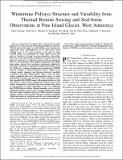Files in this item
Wintertime polynya structure and variability from thermal remote sensing and seal-borne observations at Pine Island Glacier, West Antarctica
Item metadata
| dc.contributor.author | Savidge, Elena | |
| dc.contributor.author | Snow, Tasha | |
| dc.contributor.author | Siegfried, Matthew R. | |
| dc.contributor.author | Zheng, Yixi | |
| dc.contributor.author | Villas Bôas, Ana B. | |
| dc.contributor.author | Bortolotto, Guilherme A. | |
| dc.contributor.author | Boehme, Lars | |
| dc.contributor.author | Alley, Karen E. | |
| dc.date.accessioned | 2023-05-02T11:30:07Z | |
| dc.date.available | 2023-05-02T11:30:07Z | |
| dc.date.issued | 2023-05-17 | |
| dc.identifier | 280643359 | |
| dc.identifier | 16372782-3535-4dbe-9cab-49b836cb63f4 | |
| dc.identifier | 85159705975 | |
| dc.identifier.citation | Savidge , E , Snow , T , Siegfried , M R , Zheng , Y , Villas Bôas , A B , Bortolotto , G A , Boehme , L & Alley , K E 2023 , ' Wintertime polynya structure and variability from thermal remote sensing and seal-borne observations at Pine Island Glacier, West Antarctica ' , IEEE Transactions on Geoscience and Remote Sensing , vol. 61 , 4300813 . https://doi.org/10.1109/TGRS.2023.3271453 | en |
| dc.identifier.issn | 0196-2892 | |
| dc.identifier.other | ORCID: /0000-0002-5343-6575/work/134491677 | |
| dc.identifier.uri | https://hdl.handle.net/10023/27482 | |
| dc.description | Funding: This work was enabled by the NSF-NERC International Thwaites Glacier Collaboration: Thwaites-Amundsen Regional Survey and Network (ITGC: TARSAN; NERC Grant: NE/S006419/1, NE/S006591/1, NSF Grant: 1738992) and the NERC Ice Sheet Stability Programme (iSTAR; NERC Grant: NE/J005703/1). | en |
| dc.description.abstract | Antarctica’s ice shelves play a critical role in modulating ice loss to the ocean by buttressing grounded ice upstream. With the potential to impact ice-shelf stability, persistent polynyas (open-water areas surrounded by sea ice, persisting for multipleyears at the same location) at the edge of many ice-shelffronts, are maintained by winds and/or ocean heat, and arelocations of strong ice-ocean-atmosphere interactions. However, in situ observations of polynyas are sparse due to the logistical constraints of collecting Antarctic field measurements. Here, we used wintertime (May–August) temperature and salinity observations derived from seal-borne tags deployed in 2014, 2019, and2020, in conjunction with thermal imagery from the Moderate Resolution Imaging Spectroradiometer (MODIS) and the Landsat 8 Thermal Infrared Sensor (TIRS) to investigate the spatial, temporal, and thermal structural variability of polynyas near Pine Island Glacier (PIG). Across the three winters considered, there were 148 anomalously warm (>3σ from background) sealdives near the PIG ice front, including 24 dives that coincided with MODIS images with minimal cloud cover that also showed a warm surface temperature anomaly. These warm surface temperatures correlated with ocean temperatures down to 150 m depth or deeper, depending on the year, suggesting that MODIS derived surface thermal anomalies can be used for monitoring polynya presence and structure during polar night. The finer spatial resolution (100 m) of TIRS wintertime thermal imagery captures more detailed thermal structural variability within these polynyas, which may provide year-round insight into sub-ice-shelf processes if this dataset is collected operationally. | |
| dc.format.extent | 13 | |
| dc.format.extent | 16202439 | |
| dc.language.iso | eng | |
| dc.relation.ispartof | IEEE Transactions on Geoscience and Remote Sensing | en |
| dc.subject | Polynya | en |
| dc.subject | Oceanography | en |
| dc.subject | Antarctica | en |
| dc.subject | GC Oceanography | en |
| dc.subject | QH301 Biology | en |
| dc.subject | DAS | en |
| dc.subject | SDG 14 - Life Below Water | en |
| dc.subject | MCC | en |
| dc.subject.lcc | GC | en |
| dc.subject.lcc | QH301 | en |
| dc.title | Wintertime polynya structure and variability from thermal remote sensing and seal-borne observations at Pine Island Glacier, West Antarctica | en |
| dc.type | Journal article | en |
| dc.contributor.sponsor | NERC | en |
| dc.contributor.institution | University of St Andrews. School of Biology | en |
| dc.contributor.institution | University of St Andrews. Sea Mammal Research Unit | en |
| dc.contributor.institution | University of St Andrews. Scottish Oceans Institute | en |
| dc.contributor.institution | University of St Andrews. Marine Alliance for Science & Technology Scotland | en |
| dc.identifier.doi | 10.1109/TGRS.2023.3271453 | |
| dc.description.status | Peer reviewed | en |
| dc.identifier.grantnumber | NE/S006591/1 | en |
This item appears in the following Collection(s)
Items in the St Andrews Research Repository are protected by copyright, with all rights reserved, unless otherwise indicated.

